Model parameterization to simulate and compare the PAR absorption potential of two competing plant species
- PMID: 19937454
- PMCID: PMC2860568
- DOI: 10.1007/s00484-009-0279-3
Model parameterization to simulate and compare the PAR absorption potential of two competing plant species
Abstract
Mountain pastures dominated by the pasture grass Setaria sphacelata in the Andes of southern Ecuador are heavily infested by southern bracken (Pteridium arachnoideum), a major problem for pasture management. Field observations suggest that bracken might outcompete the grass due to its competitive strength with regard to the absorption of photosynthetically active radiation (PAR). To understand the PAR absorption potential of both species, the aims of the current paper are to (1) parameterize a radiation scheme of a two-big-leaf model by deriving structural (LAI, leaf angle parameter) and optical (leaf albedo, transmittance) plant traits for average individuals from field surveys, (2) to initialize the properly parameterized radiation scheme with realistic global irradiation conditions of the Rio San Francisco Valley in the Andes of southern Ecuador, and (3) to compare the PAR absorption capabilities of both species under typical local weather conditions. Field data show that bracken reveals a slightly higher average leaf area index (LAI) and more horizontally oriented leaves in comparison to Setaria. Spectrometer measurements reveal that bracken and Setaria are characterized by a similar average leaf absorptance. Simulations with the average diurnal course of incoming solar radiation (1998-2005) and the mean leaf-sun geometry reveal that PAR absorption is fairly equal for both species. However, the comparison of typical clear and overcast days show that two parameters, (1) the relation of incoming diffuse and direct irradiance, and (2) the leaf-sun geometry play a major role for PAR absorption in the two-big-leaf approach: Under cloudy sky conditions (mainly diffuse irradiance), PAR absorption is slightly higher for Setaria while under clear sky conditions (mainly direct irradiance), the average bracken individual is characterized by a higher PAR absorption potential. (approximately 74 MJ m(-2) year(-1)). The latter situation which occurs if the maximum daily irradiance exceeds 615 W m(-2) is mainly due to the nearly orthogonal incidence of the direct solar beam onto the horizontally oriented frond area which implies a high amount of direct PAR absorption during the noon maximum of direct irradiance. Such situations of solar irradiance favoring a higher PAR absorptance of bracken occur in approximately 36% of the observation period (1998-2005). By considering the annual course of PAR irradiance in the San Francisco Valley, the clear advantage of bracken on clear days (36% of all days) is completely compensated by the slight but more frequent advantage of Setaria under overcast conditions (64% of all days). This means that neither bracken nor Setaria show a distinct advantage in PAR absorption capability under the current climatic conditions of the study area.
Figures

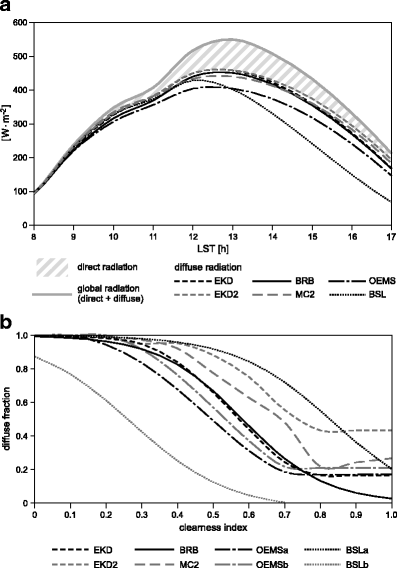

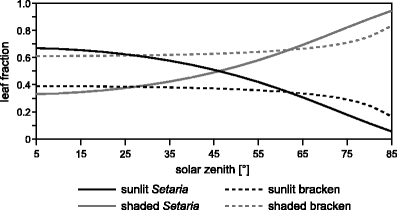
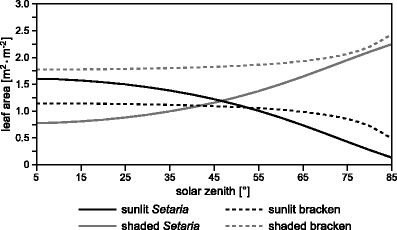
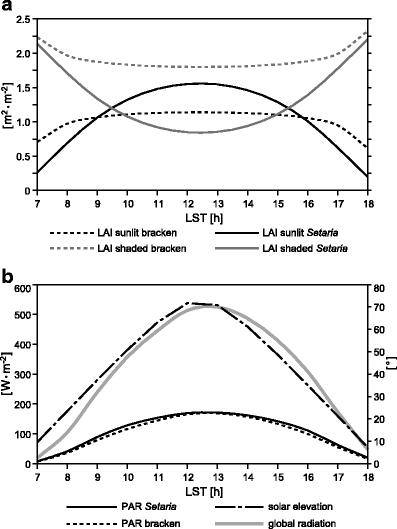


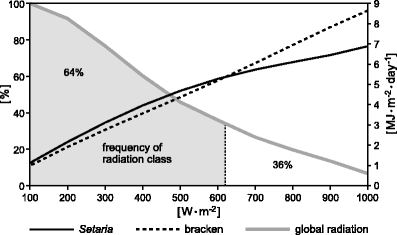
Similar articles
-
Who will win where and why? An ecophysiological dissection of the competition between a tropical pasture grass and the invasive weed Bracken over an elevation range of 1000 m in the tropical Andes.PLoS One. 2018 Aug 13;13(8):e0202255. doi: 10.1371/journal.pone.0202255. eCollection 2018. PLoS One. 2018. PMID: 30102718 Free PMC article.
-
Importance of the green color, absorption gradient, and spectral absorption of chloroplasts for the radiative energy balance of leaves.J Plant Res. 2017 May;130(3):501-514. doi: 10.1007/s10265-017-0910-z. Epub 2017 Mar 14. J Plant Res. 2017. PMID: 28293810 Free PMC article. Review.
-
Leaf color is fine-tuned on the solar spectra to avoid strand direct solar radiation.J Plant Res. 2016 Jul;129(4):615-624. doi: 10.1007/s10265-016-0809-0. Epub 2016 Mar 4. J Plant Res. 2016. PMID: 26943164
-
Analysis of photosynthetically active radiation under various sky conditions in Wuhan, Central China.Int J Biometeorol. 2014 Oct;58(8):1711-20. doi: 10.1007/s00484-013-0775-3. Epub 2013 Dec 20. Int J Biometeorol. 2014. PMID: 24357490
-
Influence of PAR and UV-A in determining plant sensitivity and photomorphogenic responses to UV-B radiation.Photochem Photobiol. 2004 Apr;79(4):307-15. doi: 10.1562/2004-01-27-ir.1. Photochem Photobiol. 2004. PMID: 15137505 Review.
Cited by
-
The dynamic relationship between plant architecture and competition.Front Plant Sci. 2014 Jun 17;5:275. doi: 10.3389/fpls.2014.00275. eCollection 2014. Front Plant Sci. 2014. PMID: 24987396 Free PMC article. Review.
-
Afforestation or intense pasturing improve the ecological and economic value of abandoned tropical farmlands.Nat Commun. 2014 Nov 26;5:5612. doi: 10.1038/ncomms6612. Nat Commun. 2014. PMID: 25425182 Free PMC article.
References
-
- Antunes MAH, Walter-Shea EA, Mesarch MA. Test of an extended mathematical approach to calculate maize leaf area index and leaf angle distribution. Agr For Meteorol. 2001;108:45–53. doi: 10.1016/S0168-1923(01)00219-2. - DOI
-
- Asner GP, Wessman CA. Scaling PAR absorption from the leaf to landscape level in spatially heterogeneous ecosystems. Ecol Model. 1997;103:81–97. doi: 10.1016/S0304-3800(97)00080-X. - DOI
-
- Barthlott W, Hostert A, Kier G, Koper W, Kreft H, Mutke J, Rafiqpoor MD, Sommer J. Geographic patterns of vascular plant diversity at continental to global scales. Erdkunde. 2007;61:305–315. doi: 10.3112/erdkunde.2007.04.01. - DOI
-
- Beck E, Hartig K, Roos K. Forest clearing by slash and burn. In: Beck E, Bendix J, Kottke I, Makeschin F, Mosandl R, editors. Gradients in a tropical mountain ecosystem of Ecuador. Berlin: Springer; 2008. pp. 371–374.
Publication types
MeSH terms
LinkOut - more resources
Full Text Sources

